Do you want to share a tank with some axolotls? Even when obligated to share a tank, axolotls typically do pretty well on their own; in fact, they instead prefer solitude. However, there are some tank mates you may consider for this bottom dweller if the tank looks a little empty.
15 best Axolotl tank mates:
- Other Axolotls
- White Cloud Mountain Minnows
- Guppy Fish
- Zebra Danios
- Apple Snails
- Small Shrimp
- Cardinal Tetra
- Endler’s Livebearers
- Rosy Barbs
- Green Swordtails
- Pearl Danios
- Orange-Finned Danios
- Dojo Loaches
- Golden Skiffia
- Mosquito Fish
Contents
Axolotl Tank Mates – What You Need to Know

Temperament
The majority of the time, axolotls flourish in seclusion. Despite this, you could try keeping them alongside other aquatic animals.
Any fish that is territorial or hostile should be avoided. These animals will pester your salamander and hurt it as a result. Swimmers who move quickly are likewise not recommended, and their motions will stress your axolotl.
Size
Even though they can’t eat them, you could see your axolotls teasing their tank mates. For this reason, selecting creatures that the axolotl can’t swallow is crucial.
Competition
It’s not a smart idea to catch other bottom-dwelling fish, either. Bottom feeders compete head-to-head for food, implying that your axolotl may intimidate its tank mates from accessing the food.
They also won’t work if the other animals are ravenous eaters. Because axolotls consume food slowly, they cannot compete for a meal with other bottom-dwelling fish.
Parameters ; Tank Setup
A tank must have at least 20 gallons to hold one adult axolotl, and it will cost more if you keep two adult axolotls in the same aquarium. A couple of axolotls require a 55-gallon tank, so you must move there. Like this, start with at least 55 gallons if you add additional fish or critters. If you have the room, go bigger since bigger is always better.
Sand is the ideal substrate for axolotl community tanks since they like digging. The axolotl now has something to do besides chasing the other neighborhood animals.
For a healthy, lively and fun aquarium, check out these top recommendations:
15 Best Axolotl Tank Mates
You might also like:
1. Other Axolotls
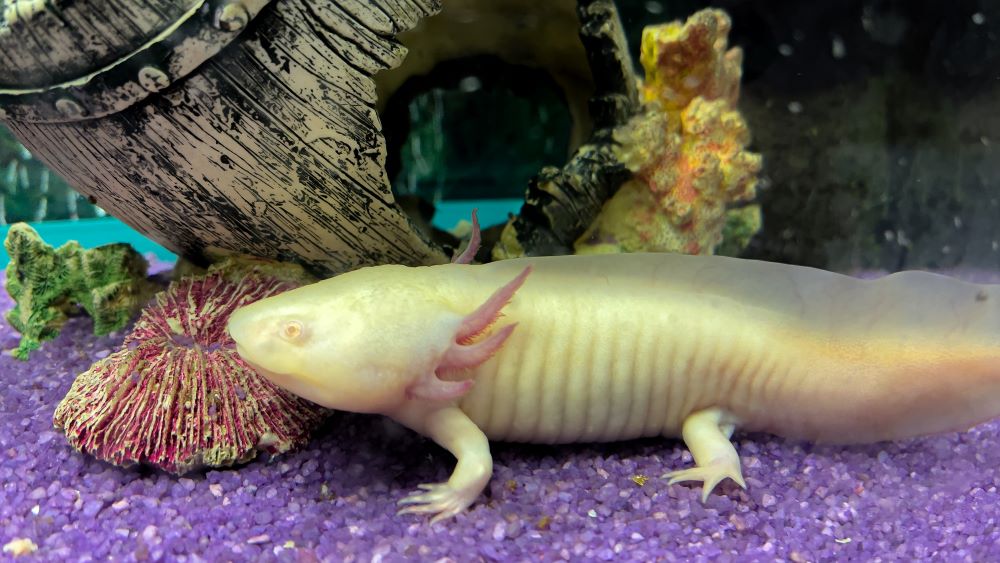
- Scientific Name: Ambystoma mexicanum
- Adult Size: 18 inches
- Compatible with: other axolotls
- Water Temperature: 60-64°F/16-18°C
- Minimum tank size: 10 gallons
- Care Level: Intermediate
- Origin: Mexico
Axolotl adults are excellent tank companions. Although keeping a male and a female together is preferable if you don’t want any offspring, you may also stay same-gender axolotls together.
It’s preferable to separate a young axolotl from a grown one, and Axolotl young should not be kept together either. They frequently act cannibalistically toward one another, and if given a chance, adults might even consume their larvae.
It would be best to segregate axolotls into various aquariums if you notice any recurring issues. It’s ideal to have only one axolotl.
Pros of keeping Axolotl with Other Axolotls:
- They have similar temperaments
- Same living conditions and diet
Cons of keeping Axolotl with Other Axolotls:
- Having male and female can result in offspring
- Young axolotl are very competitive with each other
2. White Cloud Mountain Minnows
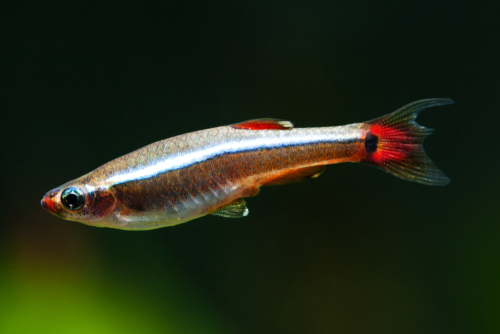
- Scientific Name: Tanichthys albonubes
- Adult Size: 1.5 inches
- Compatible with: Bloodfin Tetra
- Water Temperature: 64–72°F/18–22°C
- Minimum tank size: 10 to 12 gallons
- Care Level: Beginner
- Origin: China
Axolotls can have serene white cloud minnows in their tanks because they are cool-water fish. They are safe for axolotls to eat since they lack spines and shells, and they will occasionally be eaten, even if this may not be your aim.
Your axolotls will inevitably hunt these fish, so you may consider placing them in separate tanks. Minnows are, luckily, incredibly swift. If they aren’t caught off guard, they should be able to get away from the axolotls.
Pros of keeping Axolotl with White Cloud Mountain Minnows:
- Same water temperature requirements
- Safe for Axolotls to eat
Cons of keeping Axolotl with White Cloud Mountain Minnows:
- Axolotls with hunt them
3. Guppy Fish

- Scientific Name: Poecilia reticulata
- Adult Size: 1 – 2 inches
- Compatible with: Cardinal Tetras
- Water Temperature: 72 to 82°F/22-28°C
- Minimum tank size: 5 gallons
- Care Level: Beginner
- Origin: South America
Another fish species that seldom endangers your axolotls are guppies. Guppies will be consumed more frequently than the swift white cloud minnows. However, occasionally they do carry illnesses.
Guppie young are frequently used as feeder fish, indicating that owners give their axolotls these fish on purpose as a snack. Ingesting baby guppies by juvenile axolotls won’t endanger their health because of their small size.
Guppies breed quickly because they are livebearers. Despite eating a simple snack, your axolotl may become stressed by the rapid surge in the fish population.
Pros of keeping Axolotl with Guppy Fish:
- Mostly safe for Axolotls to eat
- Breed quickly
Cons of keeping Axolotl with Guppy Fish:
- A significant number of them might be stressful for your axolotl, and
- Guppies may chew on the fern-like gills of an axolotl.
- Smaller juvenile axolotls may choke on their prey when consuming guppies.
4. Zebra Danios
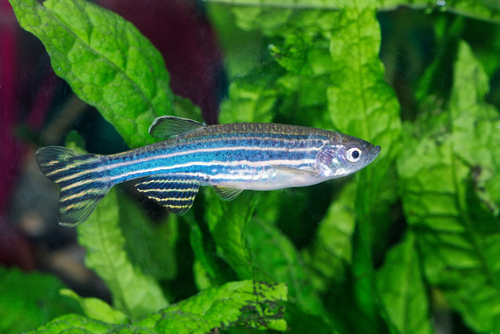
- Scientific Name: Danio rerio
- Adult Size: 2 – 2.5 inches
- Compatible with: Ember Tetras
- Water Temperature: 70 and 78°F/25°C
- Minimum tank size: 10 gallons
- Care Level: Beginner
- Origin: India
Another excellent fish to think about for calm, chilly water is the zebra danio. They will mainly avoid your axolotl and stick to their shoals. Once more, occasionally, your fish may vanish. Thankfully, zebra danios are quite nimble fish so they could have a shot in an aquarium with an axolotl.
But the fact that they can swim doesn’t mean your axolotls won’t occasionally surprise these danios.
Pros of keeping Axolotl with Zebra Danios:
- Very calm
- Will avoid Axolotls
Cons of keeping Axolotl with Zebra Danios:
- Axolotl with hunt them
5. Apple Snails
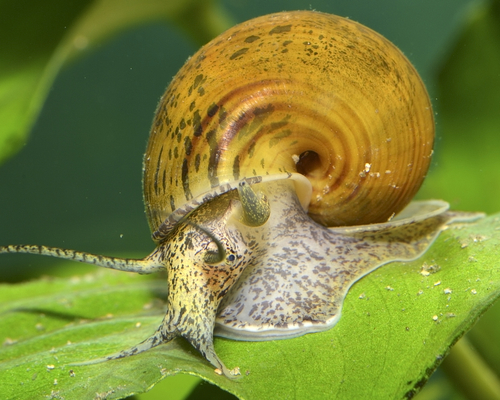
- Scientific Name: Ampullariidae
- Adult Size: 2 – 3 inches
- Compatible with: Danios
- Water Temperature: 64 to 82°F/18 to 28°C
- Minimum tank size: 10 gallons
- Care Level: Beginner
- Origin: South America
It is safe to have adult apple snails and juvenile axolotls in the same tank. They are too big for your wandering fish to consume and soft enough to partially digest but not delicate enough to be swallowed.
Avoid tiny snails and only maintain adult apple snails if you wish to keep snails. Multi snails may also be dangerous since they can climb up your axolotl and eat its slime.
Pros of keeping Axolotl with Apple Snails:
- Too big for Axolotls to eat
Cons of keeping Axolotl with Apple Snails:
- Axolotls can occasionally be at risk from the shell or exoskeleton of snails.
- It is challenging to eliminate them once they proliferate in your aquarium.
- They might have picked up infections from the outdoors.
6. Small Shrimp
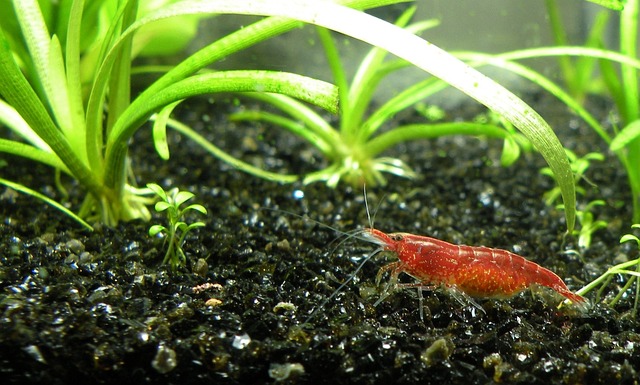
- Scientific Name: Palaemonetes paludosus
- Adult Size: 1.5 inches
- Compatible with: Small Invertebrates
- Water Temperature: 65 to 84°F/29°C
- Minimum tank size: 5 gallons
- Care Level: Intermediate
- Origin: North America
Any freshwater aquarium that includes Amano shrimp or ghost/glass shrimp will benefit from having them. Because they are good at cleaning up leftover food, these bottom feeders scrounge the substrate for nourishment. The water in your axolotl aquarium will remain clean as a result.
Shrimp may hide very well in the tank due to their virtually transparent bodies, especially if the tank has plants, but axolotls can locate them if they so want since they have keen senses of smell.
Now that they are tiny enough to be ingested without the risk of impaction, Amano shrimp are safe even if your axolotls do wind up eating them. Some owners give their axolotls shrimp as a treat sometimes.
Pros of keeping Axolotl with Small Shrimp:
- Clean leftover food
- Safe for Axolotls to eat
Cons of keeping Axolotl with Small Shrimp:
- Axolotls will hunt them
7. Cardinal Tetra

- Scientific Name: Paracheriodon Axelrod
- Adult Size: 1.25 inches
- Compatible with: Black Skirt Tetra
- Water Temperature: 73 to 81°F/23 to 27°C
- Minimum tank size: 20 gallons
- Care Level: Intermediate
- Origin: South America
Cardinal tetras are a fantastic option to give your axolotl aquarium a pop of color! These little fish are calm and won’t bother your axolotl in any way.
Since they are schooling, you should capture at least six of these blue and red fish at once. If your axolotl tries to attack, they can defend each other by banding together.
The other good news is that cardinal tetras don’t breed much, so unless you’re fortunate, you won’t have to worry about any eggs or young in your tank.
Pros of keeping Axolotl with Cardinal Tetra:
- Bright colors
- Calm and won’t bother your axolotls
- Don’t breed much
Cons of keeping Axolotl with Cardinal Tetra:
- It needs a bigger tank
- It takes some work to care for them
8. Endler’s Livebearers

- Scientific Name: Poecilia wingei
- Adult Size: 1.5 – 2 inches
- Compatible with: Shyer nano fish
- Water Temperature: 72 to 82°F/22 to 28°C
- Minimum tank size: 5 gallons
- Care Level: Moderate
- Origin: South America
Although Endler’s livebearers are not very common, they are lovely small fish. Since Endler’s livebearers belong to the same family as guppies, they may give birth alive!
These little fish are coated in vibrant colors like orange and green, and any guest to your house will surely notice them. They’ll be able to rapidly swim away from your axolotl if necessary because they’re also active.
Endler’s livebearers may be persuaded to engage with your axolotl since they are curious. Be careful to separate your axolotl if it shows signs of stress to protect both.
Pros of keeping Axolotl with Endler’s Livebearers:
- Vibrant colors
- Can swim away from Axolotls
Cons of keeping Axolotl with Endler’s Livebearers:
- They may be eaten by your axolotls as they are curious and with bother it
- May stress out your axolotl with their movement
9. Rosy Barbs

- Scientific Name: Pethia conchonius
- Adult Size: 6 inches
- Compatible with: Swordtails
- Water Temperature: 64 to 72°F/18 to 22°C
- Minimum tank size: 20 gallons
- Care Level: Intermediate
- Origin: India
Axolotls may get along well with rose barbs, one of the bigger fish on this list. They’re one of the only tankmates on this list that won’t likely end up as a snack because of their size!
Rosy barbs resemble giant goldfish in appearance but are considerably more reserved. Since they are a gentle species, they won’t likely bother your axolotl.
But bear in mind that an axolotl needs a colossal tank to accommodate a fish of this size. You need at least five rose barbs together because they are in school.
That denotes a colossal tank. Plan for at least 50 gallons to offer everyone ample room, especially considering that your axolotl will benefit from shallower water.
Pros of keeping Axolotl with Rosy Barbs:
- Bigger size so Axolotl are less likely to hunt them
- Reserved
Cons of keeping Axolotl with Rosy Barbs:
- Need multiple living together
- Need bigger tank size
10. Green Swordtails
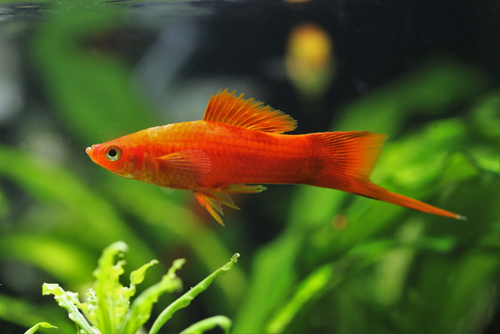
- Scientific Name: Xiphophorus helleri
- Adult Size: 5 – 6 inches
- Compatible with: Common Pleco
- Water Temperature: 72 to 79°F/26°C
- Minimum tank size: 15 gallons
- Care Level: Beginner
- Origin: Central America
A green swordtail is ideal for your aquarium if you want something distinctive-looking. The body of this fish, which is around 6 inches long, is covered in shimmering stripes.
Fish like swordtails are calm and won’t cause conflict with your axolotl. The best way to make your fish feel at home in your tank, even though they aren’t necessarily schooling fish, is to keep them together in small groups.
It is advised to have five swordtails per tank.
Remember that axolotls could be enticed to nibble on the long tail of this species. Be cautious to separate these species if you discover any serious problems so neither one nor both get injured.
Pros of keeping Axolotl with Green Swordtails:
- Distinct look
- Calm
Cons of keeping Axolotl with Green Swordtails:
- Need at least 5 per tank
- Axolotl will hunt them
11. Pearl Danios
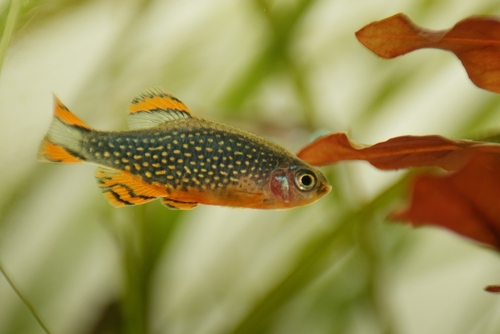
- Scientific Name: Danio albolineatus
- Adult Size: 2.5 inches
- Compatible with: Guppies
- Water Temperature: 72 to 76°F/22 to 24°C
- Minimum tank size: 10 gallons
- Care Level: Beginner
- Origin: Thailand
Pearl danios may make excellent tankmates for axolotls, just like their cousin, the zebra danio. This little fish shimmers in soft hues as it moves about your aquarium.
To feel secure, these schooling fish should be housed in groups of at least six. Furthermore, pearl danios may quickly flee from your axolotl if necessary.
Since pearl danios are calm, your axolotl won’t have any problems with them.
Pros of keeping Axolotl with Pearl Danios:
- School together for protection against axolotls
- Fast swimmers
Cons of keeping Axolotl with Pearl Danios:
- Need multiple per tank
12. Orange-Finned Danios
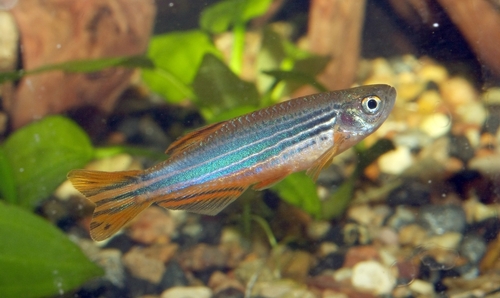
- Scientific Name: Brachydanio kyathit
- Adult Size: 1.5 – 2 inches
- Compatible with: Catfish
- Water Temperature: 61 to 79°F/16 to 26°C
- Minimum tank size: 20 gallons
- Care Level: Beginner
- Origin: Myanmar
Orange-finned danios are calm additions to any aquarium, much like the other danios on this list. Having a school of at least six fish is necessary for this friendly species to feel secure, so make sure you have a lovely little community of them.
Orange-finned danios are excellent for giving your aquarium a little more color. Their subdued orange fins give any attractive tank just the right amount of pop.
Additionally, they should be secure from any hungry axolotls because of their rapid swimming.
Pros of keeping Axolotl with Orange-Finned Danios:
- Fast swimmers to avoid axolotls
- Calm
Cons of keeping Axolotl with Orange-Finned Danios:
- Bigger tank size
- You need at least six per tank
13. Dojo Loaches

- Scientific Name: Misgurnus anguillicaudatus
- Adult Size: 6 to 8 inches
- Compatible with: White Cloud Minnows
- Water Temperature: 59 to 77°F/15 to 25°C
- Minimum tank size: 55 gallons
- Care Level: Beginner
- Origin: East Asia
Dojo loaches are a frequently forgotten aquarium buddy for axolotls. It is a species that resembles an eel slightly and prefers cold water.
Dojo eats many of the same things as axolotls, such as pellets, brine shrimp, and frozen bloodworms.
Pros of keeping Axolotl with Dojo Loaches:\
- Prefers cold water
- Similar diet
Cons of keeping Axolotl with Dojo Loaches:
- They need a much bigger tank size
14. Golden Skiffia
- Scientific Name: Skiffia francesae
- Adult Size: 1.7 inches
- Compatible with: Axolotls
- Water Temperature: 70 to 81°F/21 to 27°C
- Minimum tank size: 20 gallons
- Care Level: Moderate
- Origin: Mexico
Golden Skiffia is a rare fish that can add some interest to your aquarium. However, they prefer slightly warmer water than Axolotls and will need more room in their tank.
Pros of keeping Axolotl with Golden Skiffia:
- Interesting breed
Cons of keeping Axolotl with Golden Skiffia:
- Need slightly warm temperatures
- Need more than one per tank
15. Mosquito Fish
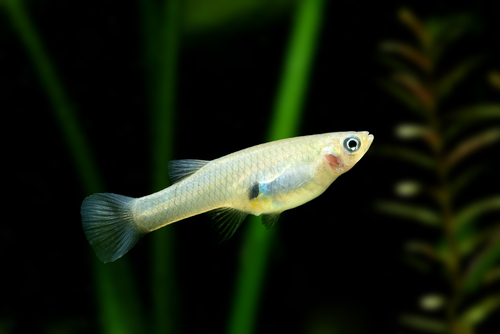
- Scientific Name: Gambusia affinis
- Adult Size: 2.5 inches
- Compatible with: Koi
- Water Temperature: 33 to 104°F/0 to 40°C
- Minimum tank size: 20 gallons
- Care Level: Beginner
- Origin: Sout-Eastern USA
There is a lot of variation with mosquito fish since the females are much bigger than the males and can survive in a wide range of temperatures. This means axolotls are less likely to hunt them and that they are more durable than some of the other fish on this list.
Pros of keeping Axolotl with Mosquito Fish:
- Like cold water
- They are large in size, so they are less likely to be eaten
Cons of keeping Axolotl with Mosquito Fish:
- Bigger tank size
Conclusion
You can decide whether or not to move ahead with this strategy in light of what you now know about axolotls and the species they may get along with. Remember that having friends in the same tank as your axolotls do carry more hazards than rewards. These aquatic salamanders even crave solitude.
Frequently Asked Questions
Do axolotls get along with other axolotls?
Generally speaking, just as adults. Younger axolotls frequently engage in cannibalism, resulting in limb loss and other issues. Be ready to have 1500 children since breeding will occur if men and females are kept together.
Will axolotls eat fish?
Yes, they will devour their fishy friends if they can catch them. There’s always a danger that one or two little fish may vanish if you keep them with an axolotl. Axolotls frequently eat small fish, including mosquito fish, as snacks.
These top recommendations will keep you axolotls happy and feeling as if they are in their natural habitat:

Ian Sterling, founder of Fishlab.com, began his aquarium journey over 30 years ago, driven by a deep fascination for fish and their diverse personalities. His website, Fishlab.com, is dedicated to making fishkeeping accessible and enjoyable, offering beginner-friendly guidance, expert insights, and a community for aquarists to connect and share experiences.





